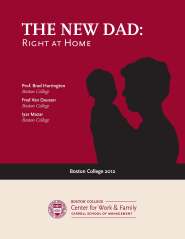There have been some amazing articles recently about women and power, the dynamics of workload, the role of millennials as future leaders, and why inclusion and diversity are critical to successful global businesses. The common thread that connects these topics is the fabric of organizational culture and the environment that helps employees thrive professionally and personally. Around the world, though work-life is called many different things: work-life balance, integration, harmony, or quality of life, the desire of employees to have engaging professional careers and care for their families is universal.
At the Boston College Center for Work & Family, I work with leading global organizations that recognize the important role that the work-life culture plays in attracting, retaining, developing and engaging an inclusive, healthy, and sustainable workforce. These organizations also recognize that the culture, legal context, gender expectations, family structure, economy, employer-employee relationship, and social norms in every country impact the policies and programs that lead to creating that successful, high performing culture.
For those organizations that are starting to develop global work-life strategies or refining already established strategies, we have found that there are 3 universal work-life issues around the globe:
• Dependent Care
• Demand for Flexibility
• Workload/Stress
Resolving these issues takes creativity and sensitivity to local culture. In France, even though the national government is considered the most appropriate institution to provide work-life supports, there is room for private sector employers to support the work-life needs of their employees and distinguish themselves as employers of choice. For example, telework and job sharing are not addressed in national labor laws and would be of great value to employees. In Korea, where employees work some of the longest hours in the world, successful company initiatives to reduce workload and stress include EAP, social and sport club activities, and additional refresh and bridge holidays. In Mexico, leveraging key cultural values (such as paternalism) as a way to advance women’s careers rather than focusing on protecting women, may provide avenues for new ways to create change in a culturally appropriate manner. Childcare support can help reduce both turnover and absenteeism. Employers can also facilitate forums through which employees can initiate cooperative childcare or caregiver-sharing.
By building a bridge between academic research and organizational practice, BCCWF provides partners with access to innovative research and corporate best practices like these, that drive competitive, integrated, data-driven work-life strategies. The next Global Workforce Roundtable meeting, on the theme of Next Generation Work-Life: Leading in a Globally Diverse and Fast-Paced World, highlights advanced global topics related to women’s advancement, the multi-generational workforce, inclusion, and workload.
Michalle Mor Barak (USC), leading global scholar on inclusion and work-life, will provide a keynote address on Clash of Values: nations, organizations and creating a climate of inclusion. Nuria Chinchilla (IESE) will join us to talk about her research on women and power. We are excited that Dennis Finn (PWC) will present on PWC’s NextGen: A global generational study one of the largest and most international studies of Millennials in the workplace. Laura den Dulk (Erasmus University) will share her expertise on work-life and workload in the European context.
As our Global Workforce Roundtable members convene in Basel, Switzerland, they will experience rich opportunities for engaging with international thought leaders, and benchmarking, networking, and sharing best practices with peer organizations to catapult global work-life strategies to the next level.
Danielle Hartmann is the Director of Corporate Partnerships at the BC Center for Work & Family. Danielle manages the Global Workforce Roundtable, a network of senior corporate leaders that seek to advance their global work-life and workforce practices. The next Global Workforce Roundtable meeting will be held, thanks to Novartis, in Basel, Switzerland on July 8-9, 2014.








